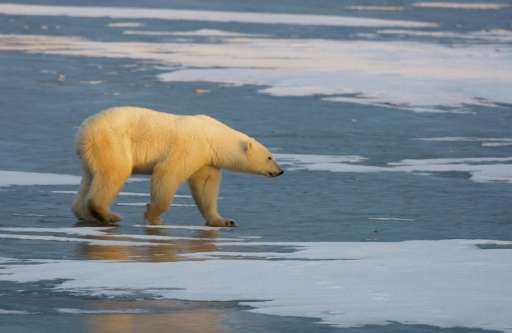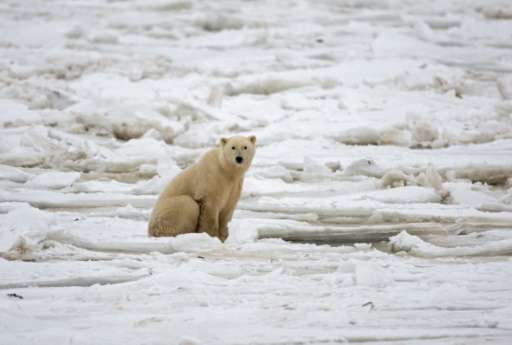Polar bears losing crucial sea ice: study

Polar bears are losing life-sustaining sea ice crucial for hunting, resting and breeding in all 19 regions of the Arctic they inhabit, a study warned on Wednesday.
As climate change pushes up Arctic temperatures, ice is melting earlier in spring and re-freezing later in autumn, a team of researchers reported in The Cryosphere, a journal of the European Geosciences Union.
Satellite data revealed that the total number of ice-covered days across the 19 regions declined at a rate of seven to 19 days per decade from 1979 to 2014, the researchers said.
"Their dependence on sea ice means that climate warming poses the single most important threat to (polar bears') persistence," wrote the team.
The global population of polar bears—scientific name Ursus maritimus—is estimated at about 25,000, said the study.
The bears, which have become emblematic of the ravages of global warming, spend most of their time on sheets of frozen ocean water, which melt and recede in warmer months, and then reform in winter.
When the ice melts, the animals come ashore and survive on stored fat until it refreezes—a period that for some has become longer and longer.
Scientists say the Arctic is warming at nearly double the global rate as a result of climate change fuelled by mankind's burning of fossil fuels, a process that emits heat-trapping greenhouse gases.
With longer iceless periods, polar bears have to swim further and further to find solid ground.

Last year, the International Union for the Conservation of Nature (IUCN) said the creatures could see their numbers dwindle by nearly a third by mid-century.
Biggest threat
Their status on the IUCN's Red List of endangered species is currently listed as "vulnerable".
The bears need sea ice for hunting as they cannot outswim seals, their preferred prey.
They get around this by waiting near holes in the ice and ambushing the seals as they come up for air.
Male and female bears also meet on ice sheets to mate.
"Changes in sea ice have been shown to impact polar bear abundance, productivity, body condition, and distribution," said the study.
According to environmental group WWF, the retreating sea ice is more frequently bringing polar bears into confrontation with humans who live on land.
With more water to navigate, Arctic shipping activities have increased, as well as opportunities for oil and gas development, further threatening the animals' habitat.
Experts say Arctic sea ice melt will in turn contribute to sea level rise, and feed back into global warming—ice reflects warming sunlight away, while water absorbs the heat.
More information: Harry L. Stern et al. Sea-ice indicators of polar bear habitat, The Cryosphere (2016). DOI: 10.5194/tc-10-2027-2016
Journal information: The Cryosphere
© 2016 AFP
















